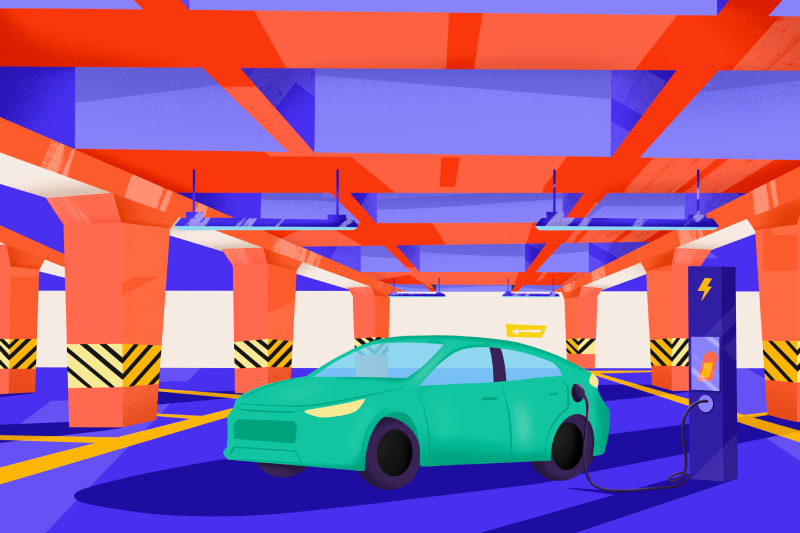Do you need to install charging points in your car park?

Electric mobility is gaining ground. On the roads, the variety of electric vehicle brands is increasing every year: Tesla, BMW, Nissan, VW, Renault, Opel, etc. Of the 4.7 million cars on the road in Switzerland, just over 110,000 are currently exclusively electric vehicles, and the trend is upwards.
According to a study by Swiss eMobility, more than 2 million people are expected to be driving electric cars in Switzerland by 2035. By 2050, almost all segments of all vehicle categories will have switched to 100% battery-electric power. However, the recharging infrastructure is not currently available to meet future demand. It will mainly be built over the next 10 to 15 years.
According to the German-language study "Verständnis Ladeinfrastruktur 2050", home charging will continue to play a central role. Whatever the scenario, the home will always be one of the places where the greatest number of recharges take place.
The home, the key location for a wide range of recharging options
Drivers can recharge their vehicles in a variety of locations:
- On the move, like a combustion engine car, thanks to fast-charging stations.
- In places where they are parked. And this is where the most frequent uses are found:
- At the workplace: many employers now offer the option of recharging their cars.
- At the place you're visiting: supermarkets, airports, railway stations, museums, etc. Here, you'll need to get out your credit card.
- And finally, where you live: directly in your garage or in the car park of your building.
The best place to recharge an electric car is where the vehicle is parked for the longest time. So mainly at home. Switzerland is a country of tenants and flat owners (building with divided ownership). Electric cars are therefore often parked in underground car parks or separate garages. How can these parking spaces be equipped with recharging infrastructure?
The process of installing a recharging system in a rental property or a building with divided ownership
a. General principle:
To install a charging system in a building, it is important to follow these 3 steps:
Preliminary work stage
This stage provides all the information needed to plan the work:
- Obtaining the owners' agreement
- Survey the needs of the residents
- Analyse the building's development strategy
- Check the building's electrical installation and estimate costs
- Analyse the supply strategy (photovoltaic, conventional network, etc.)
Planning stage
Here you can carry out all the actions required to complete the work:
- Developing an electric mobility concept: this involves defining the system chosen and which parking spaces will be equipped. A distinction should be made here between, on the one hand, the general infrastructure aspect (modification of the electrical panel, laying of electrical cables in the car park), which is generally the responsibility of the car park owner as a pre-equipment, and, on the other hand, the installation of individual charging points, which is the responsibility of the users. When choosing a solution, we recommend that you opt for an open, scalable system that will allow you to use different types of charging points and install them as needs arise.
- Request quotes from electrical installers, place orders
- Inform tenants
Completion stage
You can now proceed with the installation work to commission the charging system:
- Install and take delivery of the charging infrastructure
- Define operating conditions and responsibilities
- Hand over the charging points to the tenants
b. Specific features of the rental property:
The investment made by the owner can be rewarded either by increasing the rate per kWh or by imposing a fixed cost for "renting" the charging point.
It is possible to pre-equip (laying the flat cable) only some of the spaces in the car park and to allocate these spaces to tenants who wish to install a charging point in their parking space.
c. Specific features of the building with divided ownership:
In a building with divided ownership, the decision by the general assembly to make the investment must be taken in accordance with the official building's regulations. Generally, this decision is taken by a double majority, as it is considered to be a "useful" measure. However, it is conceivable that this will increasingly become a "necessary" measure, given the rapid spread of electric mobility. In that case, only a majority in terms of the number of owners would be required.
This decision generally consists of equipping the entire car park with a flat cable, which will then allow each resident to install a charging point in their own parking space using their own funds.
In conclusion, home charging points may have been a luxury in the past, but tomorrow they will be the norm. Installing charging points in your building today will add value by meeting tomorrow's needs.
About Climkit
Climkit has been promoting the production of photovoltaic electricity since the launch of its solution in 2017 for managing the self-consumption groups in Vevey (VD).
Since then, we have extended our offer to all forms of energy and consumption in a building: heat, cold, water, laundry, electric mobility, etc. We facilitate the management of your building thanks to our counting, billing, visualization and optimization tools. Active throughout Switzerland, we work with local professional companies for the design and installation of our products. We're also proud that our Community solution has been approved by the Solar Impulse Foundation.
Our entire team is available to assist you in your projects, as we support the 1500 RCPs who place their trust in us!
